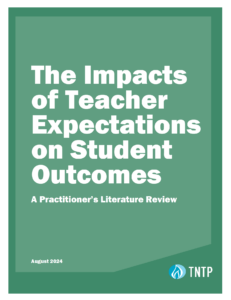Strong school leadership is inspiring, motivating and rare. It is exactly what students and teachers need to bring out their best. So what happens to a school when it loses a great leader? At TNTP, we’ve talked a lot about teacher retention over the years. But we’ve spent less time talking about principal retention: How does principal turnover affect teachers, students and school communities?
Our ears perked up when School Leaders Network published a report late last year on the effects of principal turnover on students and schools. Common sense suggests that high rates of principal “churn” would be disruptive to a school community—especially when the principals who leave are strong instructional leaders. The report puts some numbers behind that idea.
Here are some headlines:
Principal turnover affects student achievement. According to the report, principals account for about 25 percent of a school’s total influence on student academic performance. Unfortunately, the report also suggests that low-income students are likely to experience the effects of principal churn at greater rates than others. The report shows that high achieving principals tend to migrate to schools with higher income levels, higher achieving students, and fewer minorities.
Rebuilding positive momentum with a new principal takes time. It can take a new principal up to three years to regain positive momentum in math and English language arts performance—years in which student growth can stall and students lose critical learning time.
Leading change in a school requires a multi-year investment. Stable leadership matters. Keeping school leaders in place for multiple years—and improving their performance—has a positive effect on student outcomes, particularly in high-poverty schools. It takes principals an average of five years to put a vision in place for a school, improve instructional quality and fully implement policies and practices that positively affect a school’s performance. Schools that don’t retain principals beyond this point will inevitably struggle to get a foothold on meaningful change.
The study also found that principal retention isn’t just good for students—it’s also good for a school district’s bottom line. According to the study, conservative estimates put the cost to bring a new principal on board at $75,000. Many of our clients typically replace at least 25 leaders a year. That can easily turn into a $1,875,000 investment.
Of course, retaining just any principals isn’t the end goal here: As with teacher retention, the priority is first to ensure principals are effective in their roles, then figure out how to keep those great principals long enough for them to have a sustained impact on students.
At TNTP, we are currently working with school districts, charter organizations and parochial schools on recruiting, selecting and preparing new school leaders. We’re also mentoring, coaching and developing standing ones, while digging into big questions like: What role does a principal’s manager play in his or her performance? What makes an effective school leader? What can districts do to grow leaders and retain them in schools that need them most?
To parents, students and teachers, the results of the School Leaders Network report are not shocking. True instructional leadership—the transformative kind for kids—is incredibly challenging work. It’s tough to sustain year after year.
In our leadership programs, we’re looking for potential school leaders who are ready to sign on for the long haul. We’re working with our partners to build the supports principals need to stay in their roles and be effective in them. These recent findings spur us to make sure we continue to figure out the most successful ways to train and support new school leaders. It’s important we ensure their impact on kids is not only positive, but lasting.








